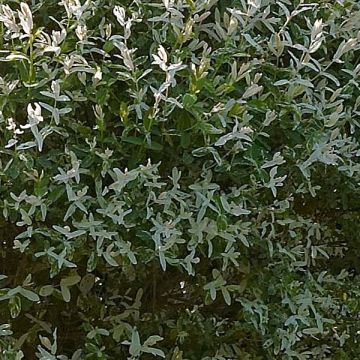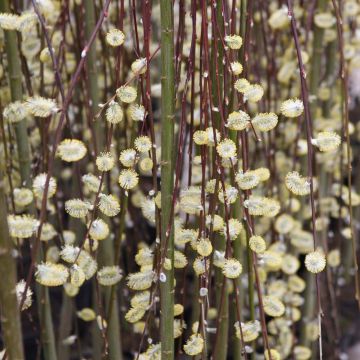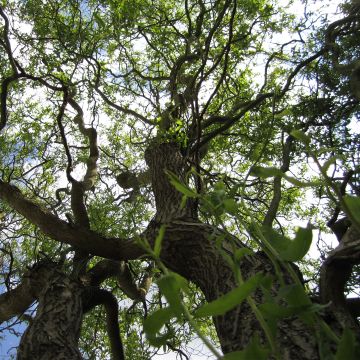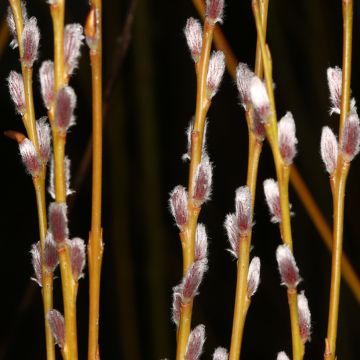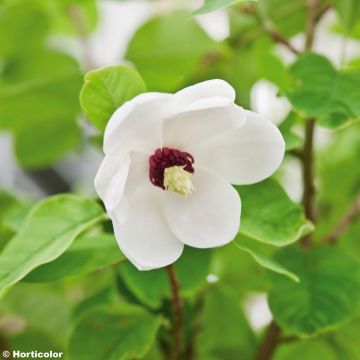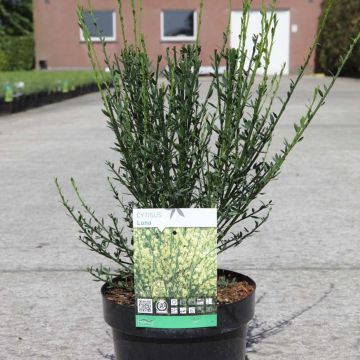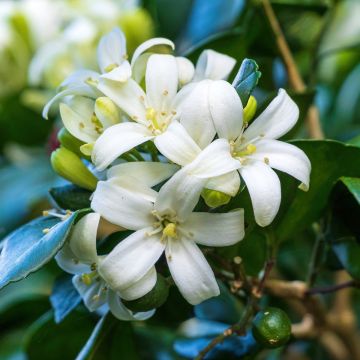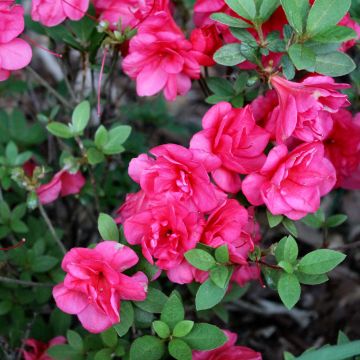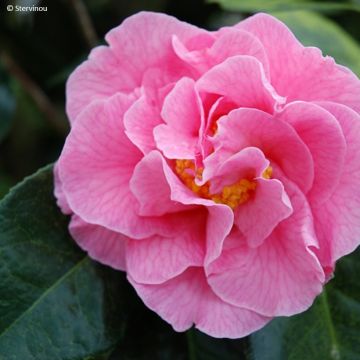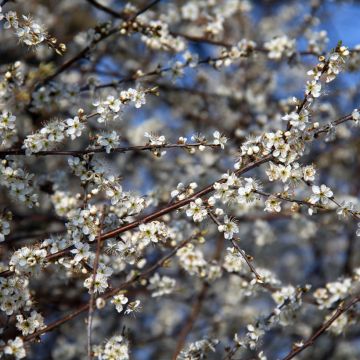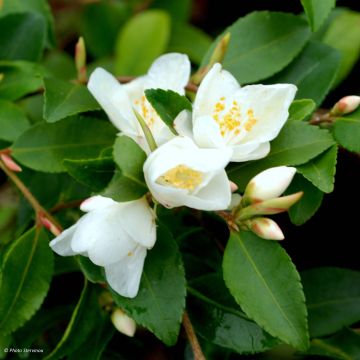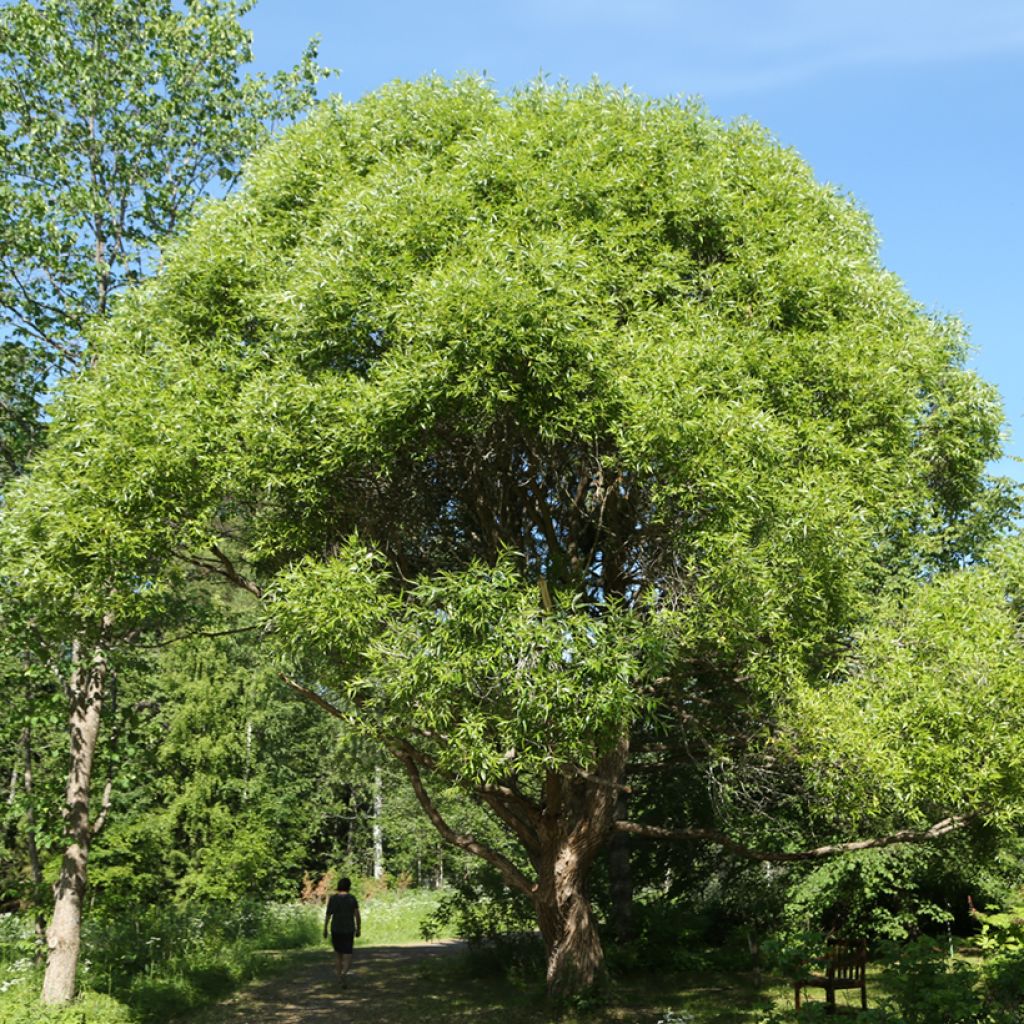

Salix x fragilis var. bullata - Crack Willow
Salix x fragilis var. bullata - Crack Willow
Salix x fragilis Bullata
Crack Willow, Brittle Willow
This item cannot be shipped to the selected country
Oversize package delivery charge from €6.90
More information
Schedule delivery date,
and select date in basket
This plant carries a 24 months recovery warranty
More information
We guarantee the quality of our plants for a full growing cycle, and will replace at our expense any plant that fails to recover under normal climatic and planting conditions.
Oversize package: home delivery by special carrier from €6.90 per order..
Express home delivery from €8.90.
Does this plant fit my garden?
Set up your Plantfit profile →
Description
Salix fragilis var. bullata is an old cultivar of brittle willow discovered in the wild in Sweden in the eighteenth century. It distinguishes itself from the species by a spherical crown and slow growth. It is selected to form a small tree with a single and straight trunk and an elliptical crown. Its branches are brittle and its dark green lanceolate foliage is shiny. It grows in non-calcareous soil, even poor soil, and tolerates wet to marshy soils. It is ideal for landscaping around large bodies of water.
Native to the plains of Europe and present in parts of Asia, Salix fragilis, also known as crack willow or red willow, is a fast-growing tree reaching between 10 and 20 metres in height and 8 to 10 metres in spread. It belongs to the Salicaceae family and the Salix genus, which includes no less than 300 species distributed in the cold regions of the northern hemisphere. Its habit is generally spreading, with the tree developing a single trunk, or even multiple trunks, topped by a wide crown supported by a few large scaffold branches. The bark is dark greyish-brown, fissured on old specimens. The long, flexible, and brittle branches are hairy when very young. They bear deciduous, lanceolate, 9 to 15 cm long, narrow leaves, not exceeding 4 cm in width. The upper surface of the leaf is shiny and dark green, the lower surface pale green. Flowering occurs in April-May, at the same time as the young leaves appear. The male and female catkins measure between 4 and 6 cm. The seeds, coated in a kind of cotton, fly away in spring and immediately germinate upon contact with moist soil. Its powerful root system, both taproot and spreading, is perfectly adapted to deep and unstable soils.
Salix fragilis var. bullata forms a slow-growing small tree with a single trunk and an elliptical crown that will reach 4 to 6 metres in height. Over time, it will measure between 5 to 9 metres in spread.
The 'Bullata' brittle willow can be planted as a specimen or along the edge of a body of water in large gardens. Among the plants that will accompany it near the water, you will find horsetails, reeds, loosestrifes, daylilies, Scirpus, and Typha angustifolia for example.
Tip: Collect fallen leaves in autumn and burn them if the tree shows black spots (anthracnose) or yellow-orange spots (rust) during its growth. Once all the leaves have fallen, treat with Bordeaux mixture.
Report an error about the product description
Plant habit
Flowering
Foliage
Botanical data
Salix
x fragilis
Bullata
Salicaceae
Crack Willow, Brittle Willow
Salix x fragilis var. spaerica
Northern Europe
Other Willow - Salix
Planting and care
Salix fragilis var. bullata is best planted in autumn, from September to November, in an acidic, moist or even swampy, quite heavy, rich to poor soil in a sunny location. It does not tolerate limestone. Water and mulch the young plants.
Planting period
Intended location
Care
This item has not been reviewed yet - be the first to leave a review about it.
Spring-flowering shrubs
Haven't found what you were looking for?
Hardiness is the lowest winter temperature a plant can endure without suffering serious damage or even dying. However, hardiness is affected by location (a sheltered area, such as a patio), protection (winter cover) and soil type (hardiness is improved by well-drained soil).

Photo Sharing Terms & Conditions
In order to encourage gardeners to interact and share their experiences, Promesse de fleurs offers various media enabling content to be uploaded onto its Site - in particular via the ‘Photo sharing’ module.
The User agrees to refrain from:
- Posting any content that is illegal, prejudicial, insulting, racist, inciteful to hatred, revisionist, contrary to public decency, that infringes on privacy or on the privacy rights of third parties, in particular the publicity rights of persons and goods, intellectual property rights, or the right to privacy.
- Submitting content on behalf of a third party;
- Impersonate the identity of a third party and/or publish any personal information about a third party;
In general, the User undertakes to refrain from any unethical behaviour.
All Content (in particular text, comments, files, images, photos, videos, creative works, etc.), which may be subject to property or intellectual property rights, image or other private rights, shall remain the property of the User, subject to the limited rights granted by the terms of the licence granted by Promesse de fleurs as stated below. Users are at liberty to publish or not to publish such Content on the Site, notably via the ‘Photo Sharing’ facility, and accept that this Content shall be made public and freely accessible, notably on the Internet.
Users further acknowledge, undertake to have ,and guarantee that they hold all necessary rights and permissions to publish such material on the Site, in particular with regard to the legislation in force pertaining to any privacy, property, intellectual property, image, or contractual rights, or rights of any other nature. By publishing such Content on the Site, Users acknowledge accepting full liability as publishers of the Content within the meaning of the law, and grant Promesse de fleurs, free of charge, an inclusive, worldwide licence for the said Content for the entire duration of its publication, including all reproduction, representation, up/downloading, displaying, performing, transmission, and storage rights.
Users also grant permission for their name to be linked to the Content and accept that this link may not always be made available.
By engaging in posting material, Users consent to their Content becoming automatically accessible on the Internet, in particular on other sites and/or blogs and/or web pages of the Promesse de fleurs site, including in particular social pages and the Promesse de fleurs catalogue.
Users may secure the removal of entrusted content free of charge by issuing a simple request via our contact form.
The flowering period indicated on our website applies to countries and regions located in USDA zone 8 (France, the United Kingdom, Ireland, the Netherlands, etc.)
It will vary according to where you live:
- In zones 9 to 10 (Italy, Spain, Greece, etc.), flowering will occur about 2 to 4 weeks earlier.
- In zones 6 to 7 (Germany, Poland, Slovenia, and lower mountainous regions), flowering will be delayed by 2 to 3 weeks.
- In zone 5 (Central Europe, Scandinavia), blooming will be delayed by 3 to 5 weeks.
In temperate climates, pruning of spring-flowering shrubs (forsythia, spireas, etc.) should be done just after flowering.
Pruning of summer-flowering shrubs (Indian Lilac, Perovskia, etc.) can be done in winter or spring.
In cold regions as well as with frost-sensitive plants, avoid pruning too early when severe frosts may still occur.
The planting period indicated on our website applies to countries and regions located in USDA zone 8 (France, United Kingdom, Ireland, Netherlands).
It will vary according to where you live:
- In Mediterranean zones (Marseille, Madrid, Milan, etc.), autumn and winter are the best planting periods.
- In continental zones (Strasbourg, Munich, Vienna, etc.), delay planting by 2 to 3 weeks in spring and bring it forward by 2 to 4 weeks in autumn.
- In mountainous regions (the Alps, Pyrenees, Carpathians, etc.), it is best to plant in late spring (May-June) or late summer (August-September).
The harvesting period indicated on our website applies to countries and regions in USDA zone 8 (France, England, Ireland, the Netherlands).
In colder areas (Scandinavia, Poland, Austria...) fruit and vegetable harvests are likely to be delayed by 3-4 weeks.
In warmer areas (Italy, Spain, Greece, etc.), harvesting will probably take place earlier, depending on weather conditions.
The sowing periods indicated on our website apply to countries and regions within USDA Zone 8 (France, UK, Ireland, Netherlands).
In colder areas (Scandinavia, Poland, Austria...), delay any outdoor sowing by 3-4 weeks, or sow under glass.
In warmer climes (Italy, Spain, Greece, etc.), bring outdoor sowing forward by a few weeks.

































